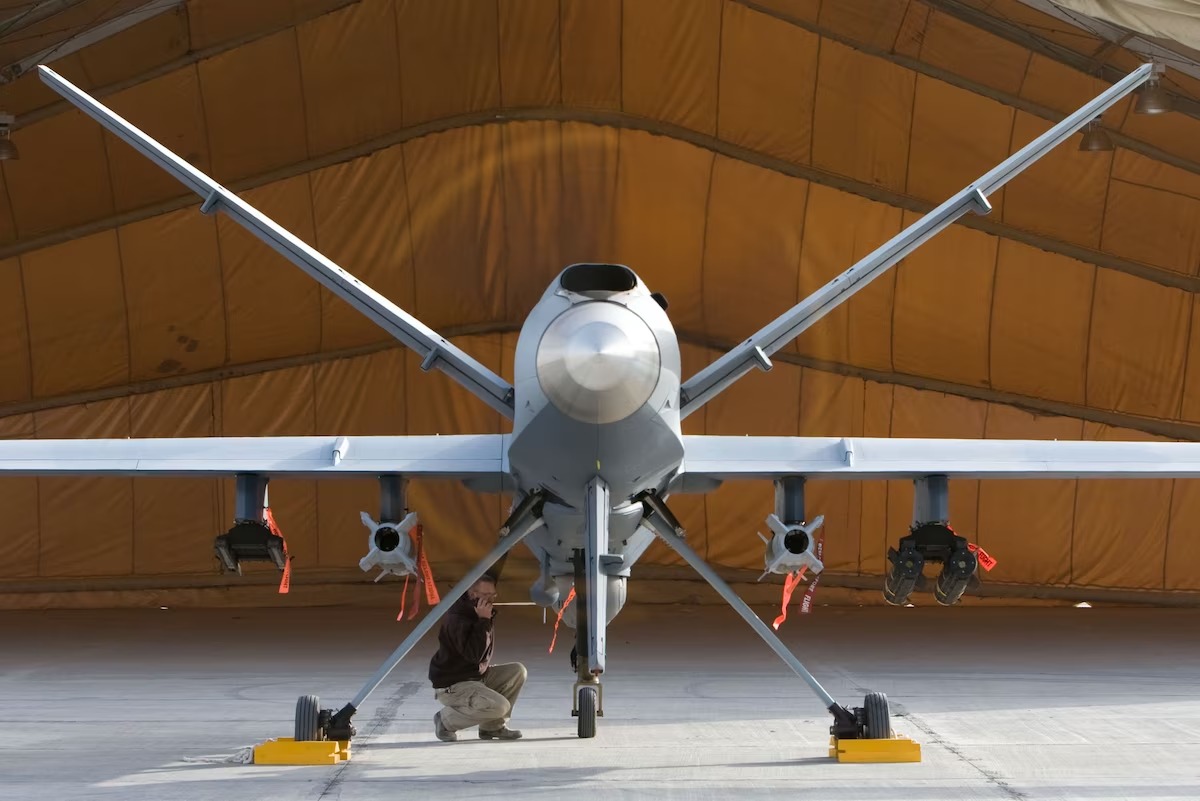US Navy Amplifies China Monitoring; After 8 MQ-9 Reapers, 2nd MQ-4C Triton Drone Deployed To Okinawa

The US Navy has deployed a second MQ-4C Triton maritime surveillance aircraft to Japan’s Kadena Air Base, besides scores of MQ-9 Reapers, marking a significant step in enhancing intelligence gathering and surveillance capabilities in the region.
As confirmed by an official from Japan’s Ministry of Defense to Okinawa Times, the aircraft arrived at the base at approximately 3:40 p.m. on June 9.
The US military has finalized its arrangements to relocate two MQ-4C Triton drones temporarily from Guam to Okinawa. The first aircraft touched down at Kadena Air Base on May 20.
According to the image published by Japanese media, both MQ-4C Tritons are stationed in the Navy tarmac hangar at the base shortly after the second aircraft’s arrival.
The Ministry of Defense and the US military have stated that the Tritons’ deployment to Kadena is planned to last from May to October. In addition to the aircraft, approximately 50 personnel are being relocated to Kadena Air Base to support the mission.
AfriPrime App link: FREE to download...
https://www.amazon.com/Africircle-AfriPrime/dp/B0D2M3F2JT
Kadena Air Base, the largest US Air Force base in the Asia-Pacific region, is strategically located. It is three hours of flight time from Beijing, Seoul, and Taipei, making it crucial for Japan’s defense.
The base frequently appears in the news due to the advanced fighter jets stationed there by the US Air Force. Currently, the US is rotating, replacing its older F-15C/D fighter jets at Kadena with newer and more advanced fighter jets.
Since announcing this rotational plan in October, the 18th Wing at Kadena has hosted various aircraft, including F-35 Lightning IIs, F-22 Raptors, US F-16s, and F-15E Strike Eagles. Additionally, the US military is boosting the presence of unmanned aerial vehicles at the base.
In addition to the MQ-4C Tritons, eight US Air Force MQ-9 drones have been stationed there since October, enhancing the base’s reconnaissance and surveillance capabilities.
Meanwhile, the Okinawa Times, citing a report from the Federal Aviation Administration (FAA), suggested that the second MQ4C Triton was scheduled to conduct a flight around Okinawa’s main island between 6 p.m. and 10:45 p.m. on June 9.
However, the plan was withdrawn from the Notice to Airmen (NOTAM) by around 4:45 p.m. on the same day, shortly after the aircraft’s arrival.
The latest deployment has not been without controversy. Okinawa Prefecture and local governments strongly oppose the indefinite presence of MQ9 drones and the temporary deployment of the MQ4C Tritons.
The Kadena Town Council has expressed worries about the potential for aircraft accidents, citing overcrowding due to the rising number of US military assets stationed at the base.

US Drones To Monitor Chinese Naval Activities
The MQ-4C Triton maritime surveillance aircraft, a creation of US-based Northrop Grumman, has had prior deployments to Misawa Air Base in northeastern Japan.
Although it resembles the well-known RQ-4 Global Hawk, celebrated for its operational history in Iraq and Afghanistan, the similarities end at the surface level.
Distinctive features of the Triton include reinforced leading edges along its wings, engineered specifically to endure impacts from bird strikes. Further, its electronic systems are meticulously crafted to withstand the abrupt surges of power induced by lightning strikes.
Leveraging their rigid wing design, these maritime drones are capable of descending rapidly to lower altitudes, facilitating close-range observation of floating targets.
Equipped with a sophisticated array of sensors and surveillance technology, the MQ-4C has showcased remarkable proficiency in delivering precise targeting information to naval assets.

This capability substantially enhances the fleet’s capacity to engage targets beyond the horizon, effectively extending its operational reach while maintaining a safe distance.
With these two advanced reconnaissance aircraft now operational at Kadena, the US military is poised to intensify its surveillance and intelligence operations in a region where China is active.
Officials have disclosed plans for drones to undertake intelligence missions in the Nansei region and its surrounding areas. The Nansei islands span from Kyushu, the southernmost of Japan’s main islands, to Taiwan, covering crucial maritime territory.
In recent years, China has escalated its challenges to neighboring countries’ maritime claims in the East and South China seas. Its coast guard frequently intrudes into waters claimed by Japan around the Senkaku Islands.
Japan perceives China’s recurrent incursions as a strategy to undermine Tokyo’s ability to assert effective control over the uninhabited islands, thereby casting doubts on its sovereignty.
Concerns have been raised that continued Chinese vessel operations near the islands without repercussions could compromise Japan’s claim. Tokyo has witnessed a significant uptick in the number of Chinese ships approaching the islands, with prolonged duration of stays.
Drones dramatically enhance surveillance capabilities for extended periods. Additionally, their non-provocative nature and sole purpose of monitoring other vessels make them a valuable asset for deployment.
AfriPrime App link: FREE to download...
- Questions and Answers
- Opinion
- Story/Motivational/Inspiring
- Technology
- Art
- Causes
- Crafts
- Dance
- Drinks
- Film/Movie
- Fitness
- Food
- Игры
- Gardening
- Health
- Главная
- Literature
- Music
- Networking
- Другое
- Party
- Religion
- Shopping
- Sports
- Theater
- Wellness
- News
- Culture
- War machines and policy

